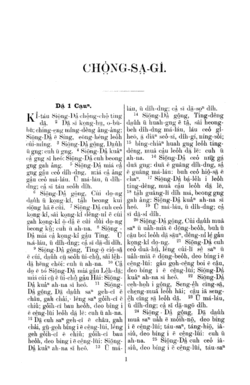
Hinghwa Romanized
| Hinghwa Romanized Hing-hua̍ báⁿ-uā-ci̍ | |
|---|---|
 Bible in Hinghwa (Xinghua) Romanized (Genesis), published by the British and Foreign Bible Society. | |
| Script type | (modified) |
| Creator | William N. Brewster |
Time period | 1890 — 1950 |
| Languages | Putian dialect of the Pu-Xian Min language |
| Related scripts | |
Parent systems | |
| Transliteration of Chinese |
|---|
| Mandarin |
| Wu |
| Yue |
| Min |
| Gan |
| Hakka |
| Xiang |
| Polylectal |
| See also |
Hinghwa Romanized, also known as Hing-hua̍ báⁿ-uā-ci̍ (興化平話字) or Báⁿ-uā-ci̍ (平話字), is a Latin alphabet of the Putian dialect of Pu-Xian Chinese. It was invented by William N. Brewster (蒲魯士), an American Methodist pioneer missionary in Hinghwa (modern Putian) in 1890.

Writing system
Alphabet
Hinghwa Romanized has 23 letters: a a̤ b c ch d e e̤ g h i k l m n ng o o̤ p s t u ṳ.

| Bilabial | Alveolar | Lateral | Velar | Glottal | ||
|---|---|---|---|---|---|---|
| Plosive | unaspirated | p 巴 (b) | t 打 (d) | k 家 (g) | ʔ 烏 | |
| aspirated | pʰ 彭 (p) | tʰ 他 (t) | kʰ 卡 (k) | |||
| Nasals | m 麻 (m) | n 拿 (n) | ŋ 雅 (ng) | |||
| Fricatives | voiceless | ɬ 沙 (s) | h 下 (h) | |||
| voiced | ||||||
| Affricates | unaspirated | ts 渣 (c) | ||||
| aspirated | tsʰ 査 (ch) | |||||
| Approximant | l 拉 (l) | |||||
Finals
| Vowel | Diphthong | Nasal | Glottal | |
|---|---|---|---|---|
| no glide | a 鴉 (a) | au 拗 (au) | aŋ 王 (ang) | aʔ 壓 (ah) |
| ɒ 奥 (o̤) | ɒŋ 用 (o̤ng) | ɒʔ 屋 (o̤h) | ||
| o 科 (eo) | ɔu 烏 (o) | oŋ 温 (eong) | oʔ 熨 (eoh) | |
| e 裔 (a̤) | ai 愛 (ai) | ɛŋ 煙 (eng) | ɛʔ 黑 (eh) | |
| œ 改 (e̤) | œŋ 換 (e̤ng) | œʔ 郁 (e̤h) | ||
| ŋ 伓 (ng) | ||||
| /-i-/ | i 衣 (i) | iu 油 (iu) | iŋ 引 (ing) | iʔ 益 (ih) |
| ia 夜 (ia) | iau 要 (a̤u) | iaŋ 鹽 (iang) | iaʔ 葉 (iah) | |
| /-u-/ | u 夫 (u) | ui 位 (ui) | uŋ 黄 (ng) | |
| ua 画 (ua) | ue 歪 (oi) | uaŋ 碗 (uang) | uaʔ 活 (uah) | |
| /-y-/ | y 余 (ṳ) | yŋ 恩 (ṳng) | yʔ 役 (ṳh) | |
| yɒ 安 (io̤ⁿ) | yɒŋ 羊 (io̤ng) | yɒʔ 藥 (io̤h) |
Tone
| Tone | Ing-báⁿ 陰平 | Ing-siō̤ng 陰上 | Ing-kṳ̍ 陰去 | Ing-ci̍h 陰入 | Ió̤ng-báⁿ 陽平 | Ió̤ng-kṳ̍ 陽去 | Ió̤ng-ci̍h 陽入 |
| Hinghwa Romanized | none (a) | ˆ (â) | ˈ (a̍) | none (ah) | ́ (á) | ¯ (ā) | ˈ (a̍h) |
| Putian | ˥˧˧ (533) | ˦˥˧ (453) | ˦˨ (42) | ʔ˨˩ (ʔ21) | ˩˧ (13) | ˩ (11) | ʔ˦ (ʔ4) |
| Xianyou | ˥˦˦ (544) | ˧˧˨ (332) | ˥˨ (52) | ʔ˨ (ʔ2) | ˨˦ (24) | ˨˩ (21) | ʔ˦ (ʔ4) |
Example text
Tai̍-che̤ ū Dō̤, Dō̤ gah Siō̤ng-Da̤̍ dó̤ng-cāi, Dō̤ cuh sī Siō̤ng-Da̤̍. Ca̤̍ Dō̤ ta̍i-che̤ gah Sio̤ng-Da̤̍ dó̤ng-cāi. Māng-beo̍h sī ciā da̤u̍h I cho̤̍ ē; hang pī cho̤̍, beo̍ seo̍h-ā̤uⁿ ng-sī ciā da̤u̍h I cho̤̍ ē.

太初有道,道佮上帝同在,道就是上帝。這道太初佮上帝同在。萬物是借著伊造兮,含被造兮,無一樣呣是借著伊造兮。

In the beginning was the Word, and the Word was with God, and the Word was God. The same was in the beginning with God. All things were made by him; and without him was not any thing made that was made. (John 1:1-3 KJV)

Compared with Pe̍h-ōe-jī and Foochow Romanized
| IPA | Hinghwa Romanized | Foochow Romanized |
| pʰ | p | p |
| tʰ | t | t |
| kʰ | k | k |
| p | b | b |
| t | d | d |
| k | g | g |
| tsʰ | ch | ch |
| ts | c | c |
| Tone | 陰平 Ing-báⁿ | 陰上 Ing-siō̤ng | 陰去 Ing-kṳ̍ | 陰入 Ing-ci̍h | 陽平 Ió̤ng-báⁿ | 陽去 Ió̤ng-kṳ̍ | 陽入 Ió̤ng-ci̍h |
| Hinghwa Romanized | a | â | a̍ | ah | á | ā | a̍h |
| Pe̍h-ōe-jī | a | á | à | ah | â | ā | a̍h |
References
- 刘福铸:兴化话罗马字研究
- 高德矞:兴化话与罗马字
External links
See what we do next...
OR
By submitting your email or phone number, you're giving mschf permission to send you email and/or recurring marketing texts. Data rates may apply. Text stop to cancel, help for help.
Success: You're subscribed now !
